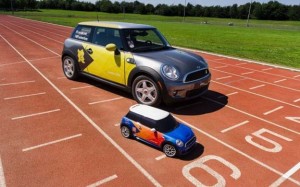They are some of the oldest sports in the Olympics, dating back to the days of the ancient Greeks, but even events like the javelin, discus and hammer throws are getting a modern update with the help of British automaker Mini.
Call it Mini Me, perhaps, but the BMW subsidiary has come up with an even more downsized version of its familiar microcars that save valuable time during competition by bringing javelins, hammers and shots back from the field to the throwing area.
There are, in fact, three Mini Minis, each a quarter the size of a real car. They’re battery-powered and remote controlled. They’re being put to the test during nine days of Olympic competition that will be followed by another nine days in the Paralympics.
“The MINI team was thrilled to be given this challenge to develop a vehicle with such an important and high profile role during the Olympic and Paralympic Games,” commented Dr Juergen Hedrich, Managing Director of MINI Plant Oxford. “I know that everybody was inspired by the challenge and the knowledge that these models will be seen in action by millions of people around the world.”
Each of the robotic Mini Minis can operate for about 35 minutes of continuous use between charges – though they actually spend a lot of time, just like the athletes, waiting on the sidelines. They’re expected to log about four miles on their micro-odometers every day.
After an athlete tosses a discus or hammer, one of the cars is sent into the field where an Olympic official loads the equipment through a modified sunroof.
The vehicles got off to a somewhat shaky start as operators figured out how to steer them across the fields without running into officials, athletes and equipment.
But they’ve also generated a bit of criticism from those who feel the presence of the Minis violates the Olympics’ ban on advertising on the field of play. Proponents, however, note there are no obvious logos and that the vehicles are no more promotional than the Nike “swooshes” found on the gear worn by countless Olympic athletes.
The little vehicles are otherwise precise replicas of the Minis being used by Olympic athletes and officials, down to their paint scheme. The scale models, however, feature lightweight composite bodyshells and are powered by 10 horsepower electric motors. They have special, heavy-duty shocks and tires designed to run on grass, as well as dual vented disc brakes.
While Mini might seem a natural to play a role in the 2012 London Olympics it actually got there through its parent company, BMW, the official automotive sponsor of the summer games. The Bavarian maker has fielded 100s of vehicles from its various divisions, with an emphasis on green technology. That includes 160 of its BMW 1-Series Active E electric vehicles. The Mini brand added another 200 cars to the official Olympic fleet – including Countryman crossovers and Mini E electric vehicles.
The British brand is also offering a retail model celebrating its role in the London games, dubbed the Mini London 2012 edition, it features Union Jack stripes and a London skyline scene etched across the instrument panel. At 17,980 pounds, or $27,920, it also costs about 50% more than a standard-issue model.

